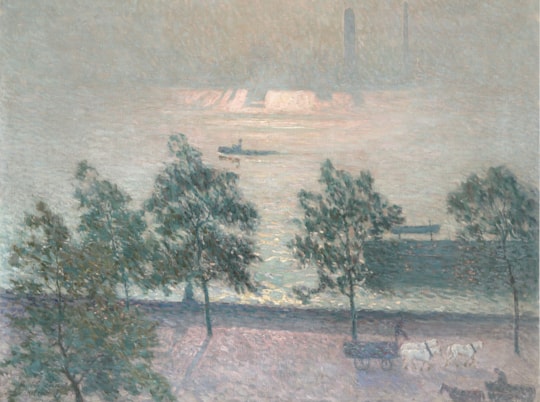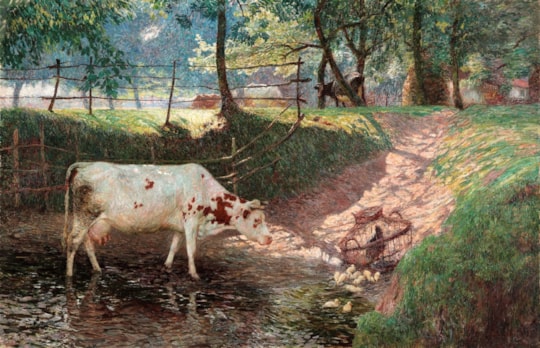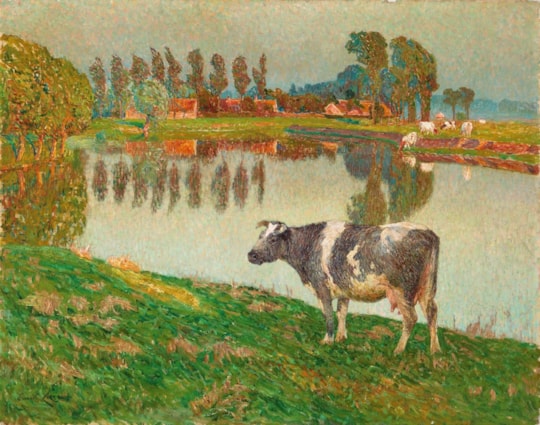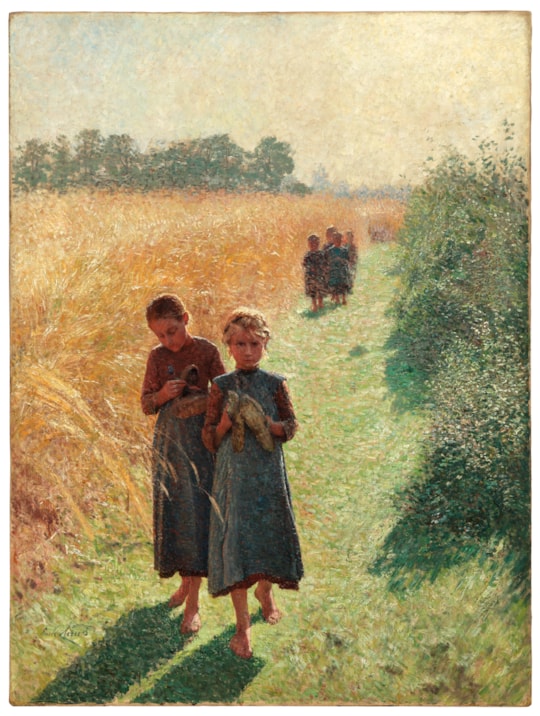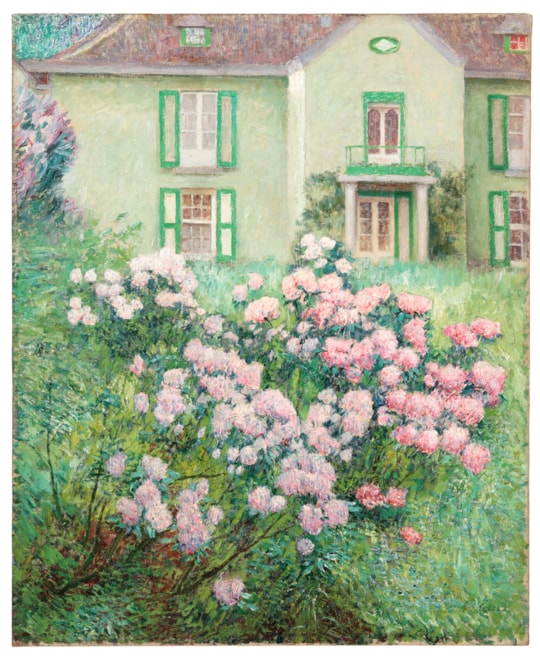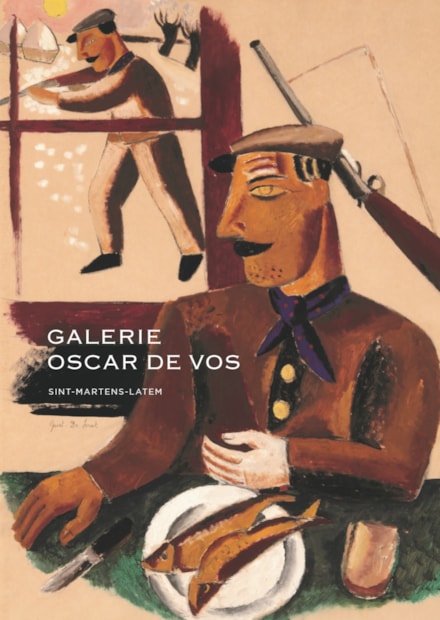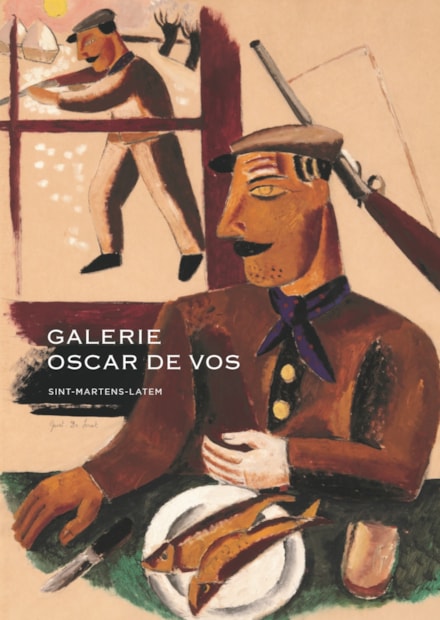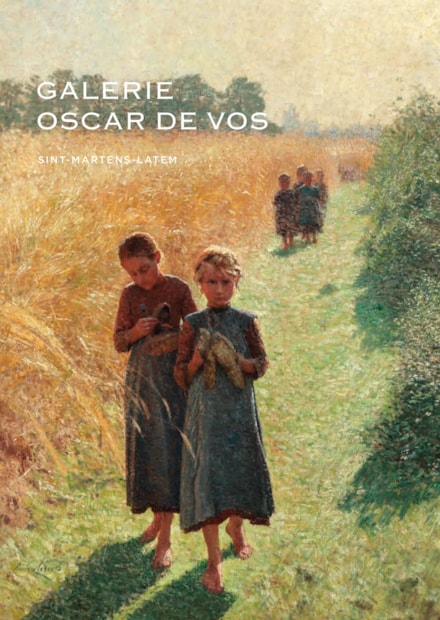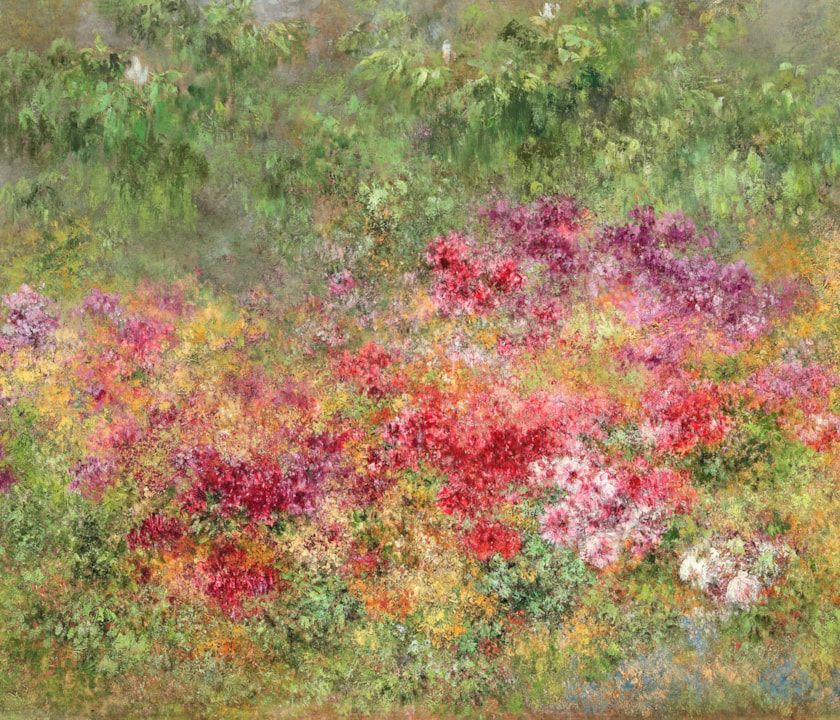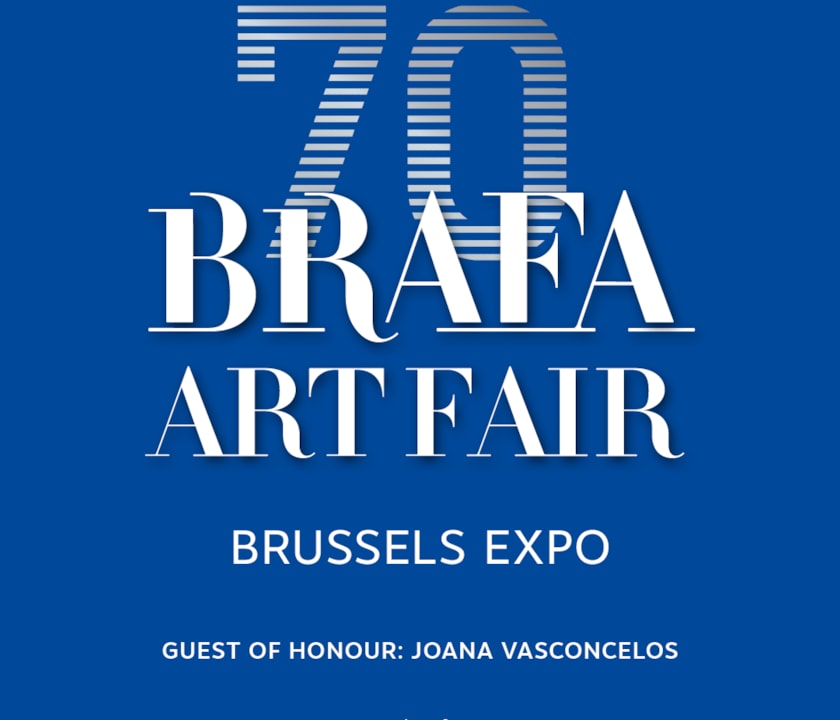Emile Claus
(1849 - 1924)
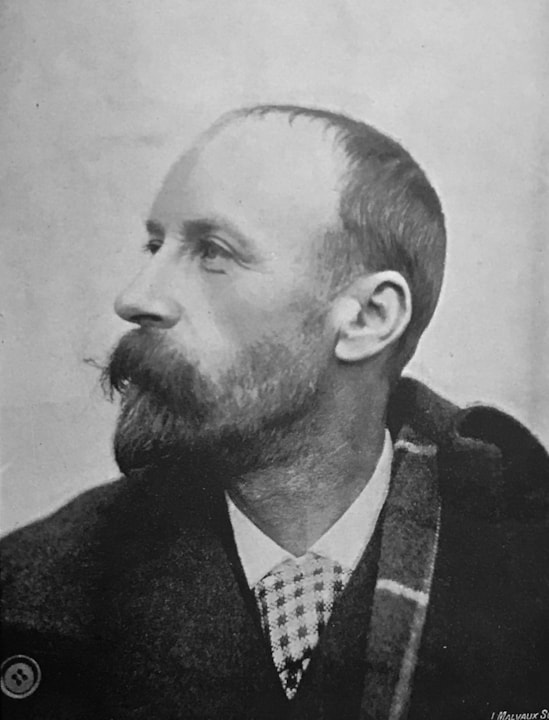
Emile Claus
(1849 - 1924)
Met de hulp van Peter Benoit kon Emile Claus van 1869 tot 1874 aan de Antwerpse Academie voor Schone Kunsten studeren. Claus was afkomstig uit een bescheiden milieu, dat zijn kunstambities maar matig apprecieerde. Toch zou de jongeman op korte tijd een plaats verwerven in het Antwerpse kunstleven. In 1874, nauwelijks afgestudeerd, zond hij werk in voor de driejaarlijkse salon van Gent ; zijn inzending werd meteen aanvaard. Hoewel hij de eerste jaren vooral als portrettist actief was, maakte hij stilaan naam als landschapschilder. Vooral na zijn oriëntalistische reis naar Noord-Afrika en Spanje en een verblijf in Domburg sprak hij de taal van de natuur. Ondertussen betoonde hij zich uiterst actief in het Antwerpse kunstmilieu, samen met zijn academie-vrienden Frans Hens en Théodore Verstraete. Op de tentoonstellingen van de plaatselijke Cercle Artistique et Littéraire zetten ze zich tegen de conservatieve Antwerpse kunstscène af. Langzamerhand profileerde de kunstenaar zich op de belangrijke tentoonstellingen in binnen- en buitenland, van Brussel tot Parijs; circa 1889 genoot hij een grote bekendheid in Frankrijk, Groot-Brittannië en Duitsland.
Tot zijn huwelijk in 1886 behield Claus een pied-à-terre in Antwerpen. Maar creatief betoonde hij zich vooral in en om Astene, in de directe omgeving rond het landhuis dat hij vanaf 1881 betrok. Vanuit het landhuis, dat later omgedoopt werd tot Villa Zonneschijn, had hij een panoramisch zicht op de Leie en de bossen rond het kasteel van Ooidonk. De monumentale doeken die hij op de Belgische en Parijse salons toonde, ontstonden in rond Villa Zonneschijn. Met deze schilderijen kende hij bijzonder veel succes, maar als kunstenaar voelde hij zich nog niet volgroeid. In de winters van 1889 tot 1891 verbleef hij in Parijs, waar hij de directe confrontatie aanging met de moderne schilderkunst. Daarnaast werd hij via de vooraanstaande romancier en kunstcriticus Camille Lemonnier geïntroduceerd in Parijse kunstmiddens, en legde hij contacten met in Parijs verblijvende kunstenaars, zoals Henri Duhem, Henri Le Sidaner, Frits Thaulow, Anders Zorn, e.a. Aan zijn streekgenoot en vriend Albijn van den Abeele schreef hij vanuit Parijs: “Zeker is Parijs verleidelijk en biedt aan den schilder prachtige tooneelen: dien wemelenden menschenzwerm op straten en boulevards bij regen of zon, de Seine dien breeden stroom gedurig doorsneden van fluitende stoombootjes, die door hunne rossen, zwarte damp de talrijke bruggen in eenen nevel hult, die ontelbare reuzegebouwen. Kortom gansch dat woelende leven in die groote wereldstad is een schat voor hem die daar zijn lievelingen van maakt”.
Vanaf het ogenblik dat Claus voor het modernistische impressionisme koos, kwam hij in beeld in progressieve kringen in België. Vanaf 1894 werd hij volwaardig lid van de kunstenaarsvereniging La Libre Esthétique die in het Brusselse Musée Moderne de traditie van Les XX voortzette. In een ruk werd hij niet langer geassocieerd met het Antwerpse academisme waartoe hij nog in 1889 gerekend werd.
Claus’ onverwachte keuze voor het impressionisme, stoorde zijn Belgische cliënteel in hoge mate. Toch zette hij door, en kende reeds snel officieel succes met zijn impressionisme ; in 1892 kocht het Gentse Museum voor Schone Kunsten het schilderij De ijsvogels, een van de vroegste voldragen impressionistische werken van Claus. Schoorvoetend zou het Belgische publiek volgen. Rond 1900 was Claus de onbetwiste leider van het Belgische impressionisme, bekroond door een gouden medaille op de Parijse Exposition universelle. Ook in Parijs had hij toegang tot de progressieve milieus ; de vooraanstaande Galerie Georges Petit was vanaf 1895 Claus’ vertegenwoordiger in Parijs. Eerder nam Claus zijn plaats in het vooruitstrevende cenakel van de Champs de Mars in, de Parijse tentoonstellingen die zich afzetten tegenover het officiële Parijse salon.
In 1904 stond Claus mede aan de wieg van de kunstenaarsvereniging Vie et Lumière, die de Belgische impressionisten verenigde. Claus’ binnen- en buitenlandse successen volgden elkaar op, zodat hij aan de vooravond van de Eerste Wereldoorlog een gevierd kunstenaar was in Europa.
Bij het begin van de oorlog vluchtte hij naar Groot-Brittannië. Na een kort verblijf in Wales keerde hij terug naar Londen waar hij tot de bevrijding zou verblijven. Ook in Londen kende Claus bijval, onder meer door de opgemerkte tentoonstelling in de Goupil Gallery in 1917.
Tot zijn huwelijk in 1886 behield Claus een pied-à-terre in Antwerpen. Maar creatief betoonde hij zich vooral in en om Astene, in de directe omgeving rond het landhuis dat hij vanaf 1881 betrok. Vanuit het landhuis, dat later omgedoopt werd tot Villa Zonneschijn, had hij een panoramisch zicht op de Leie en de bossen rond het kasteel van Ooidonk. De monumentale doeken die hij op de Belgische en Parijse salons toonde, ontstonden in rond Villa Zonneschijn. Met deze schilderijen kende hij bijzonder veel succes, maar als kunstenaar voelde hij zich nog niet volgroeid. In de winters van 1889 tot 1891 verbleef hij in Parijs, waar hij de directe confrontatie aanging met de moderne schilderkunst. Daarnaast werd hij via de vooraanstaande romancier en kunstcriticus Camille Lemonnier geïntroduceerd in Parijse kunstmiddens, en legde hij contacten met in Parijs verblijvende kunstenaars, zoals Henri Duhem, Henri Le Sidaner, Frits Thaulow, Anders Zorn, e.a. Aan zijn streekgenoot en vriend Albijn van den Abeele schreef hij vanuit Parijs: “Zeker is Parijs verleidelijk en biedt aan den schilder prachtige tooneelen: dien wemelenden menschenzwerm op straten en boulevards bij regen of zon, de Seine dien breeden stroom gedurig doorsneden van fluitende stoombootjes, die door hunne rossen, zwarte damp de talrijke bruggen in eenen nevel hult, die ontelbare reuzegebouwen. Kortom gansch dat woelende leven in die groote wereldstad is een schat voor hem die daar zijn lievelingen van maakt”.
Vanaf het ogenblik dat Claus voor het modernistische impressionisme koos, kwam hij in beeld in progressieve kringen in België. Vanaf 1894 werd hij volwaardig lid van de kunstenaarsvereniging La Libre Esthétique die in het Brusselse Musée Moderne de traditie van Les XX voortzette. In een ruk werd hij niet langer geassocieerd met het Antwerpse academisme waartoe hij nog in 1889 gerekend werd.
Claus’ onverwachte keuze voor het impressionisme, stoorde zijn Belgische cliënteel in hoge mate. Toch zette hij door, en kende reeds snel officieel succes met zijn impressionisme ; in 1892 kocht het Gentse Museum voor Schone Kunsten het schilderij De ijsvogels, een van de vroegste voldragen impressionistische werken van Claus. Schoorvoetend zou het Belgische publiek volgen. Rond 1900 was Claus de onbetwiste leider van het Belgische impressionisme, bekroond door een gouden medaille op de Parijse Exposition universelle. Ook in Parijs had hij toegang tot de progressieve milieus ; de vooraanstaande Galerie Georges Petit was vanaf 1895 Claus’ vertegenwoordiger in Parijs. Eerder nam Claus zijn plaats in het vooruitstrevende cenakel van de Champs de Mars in, de Parijse tentoonstellingen die zich afzetten tegenover het officiële Parijse salon.
In 1904 stond Claus mede aan de wieg van de kunstenaarsvereniging Vie et Lumière, die de Belgische impressionisten verenigde. Claus’ binnen- en buitenlandse successen volgden elkaar op, zodat hij aan de vooravond van de Eerste Wereldoorlog een gevierd kunstenaar was in Europa.
Bij het begin van de oorlog vluchtte hij naar Groot-Brittannië. Na een kort verblijf in Wales keerde hij terug naar Londen waar hij tot de bevrijding zou verblijven. Ook in Londen kende Claus bijval, onder meer door de opgemerkte tentoonstelling in de Goupil Gallery in 1917.
werken
publicaties
BRAFA 2020 (French Version)


.tif?width=540&height=1000&quality=90&format=jpeg&mode=max)
